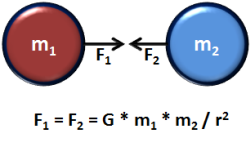The Force of Gravity calculator computes the gravitational force between two masses (m1 and m2) separated by a specified distance (R).
INSTRUCTIONS: Choose units and enter the following:
- (M1) Mass of object 1
- (M2) Mass of object 2
- (R) Distance between objects.
Force of Gravity (F): The force of gravity is returned in newtons. However, this can be automatically converted to other force units via the pull-down menu.
Note: vCalc provides special mass and distance units for application in space sciences. The mass units include Earth Mass, Jupiter Mass and Solar Mass. The distances include Astronomical Units (au), Light Seconds, Minutes, Hours, Days and Years, Parsecs, Kilo-Parsecs and Kilo-Light Years.
The Science
The Force of Gravity equation computes the gravitational force between two masses. In this equation, the masses are treated as point masses separated by a specified distance. The Force of Gravity equation is as follows:
F = (G•m1•m2)/R²
where:
- F = force of gravity
- G = Universal Gravitational Constant is 6.67384E-11 m³/kg•sec².
- m1 = mass of the first object
- m2 = mass of the second object
- R = Radius associated with a force of gravity between two masses
 Force of Gravity
Force of Gravity
Gravity Calculators:
- Acceleration Due to Gravity
- Acceleration Due to Gravity based on Latitude
- Acceleration Due to Gravity based on Altitude
- Acceleration Due to Gravity on Earth at Sea Level
- Force of Gravity between two Objects
- Universal Gravity Constant (G)
Reference
- http://en.wikipedia.org/wiki/Gravitation
- http://en.wikipedia.org/wiki/Newton%27s_law_of_universal_gravitation